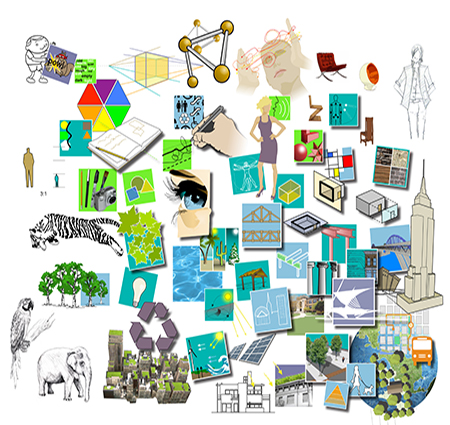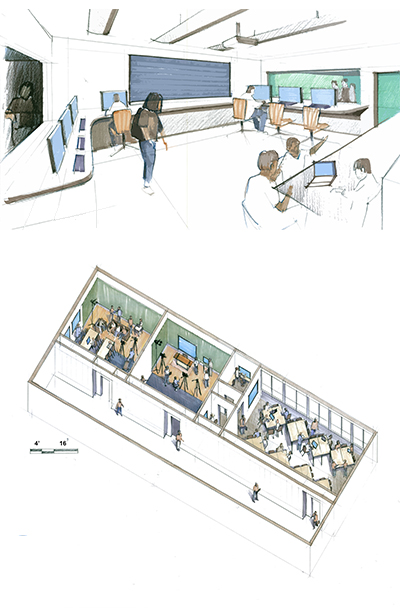
It is people’s nature to make things. They make things for enjoyment, to organize, to discover, to learn, to collaborate, to communicate, and to solve problems and improve conditions. In fact, making is a process that pervades everyone’s daily life from making food, playing music, painting, dressing, etc. When we look at the world around us, we can see millions of products, systems, and experiences that people have made. Makerspaces are places where people make. Makerspaces throughout history were shops and workrooms of trades and craft guilds. People made cloth, built furniture, made shoes and clothing, baked bread, painted paintings, and constructed all kinds of things. Administrators and teachers are renewing their interest in makerspaces around the world educating through project based learning in schools, on school campuses and out in the community. Makerspaces are all encompassing or themed. What kind of zones are needed in a makerspace? Think ideation, iteration, reflection, production, evaluation, collaboration and presentation. This journey introduces making a cross the curriculum inside schools and out onto school campuses. Be a maker!
Activity 1 – Wellness Makerspace
Education is about living healthy in our relationships with ourselves, with each other, and within our environment. A wellness makerspace provides opportunities for personal development and learning through the making of projects that encourage healthy behavior throughout all life stages. Healthy individuals promote healthier communities.
A wellness makerspace explores building a healthy body through movement- walking, cardio activities, weight lifting, free weights, flexibility training and relaxation and strengthening exercises including yoga, pilates, kickboxing, and exercise bootcamps. Students gain knowledge about preparation for a lifetime of fitness and experience the fun of social exercising. Making in a wellness makerspace includes student creation of motivational posters that connect movement with desired fitness levels, data charts of heart rate monitoring, steps walked, and calories burned achieved.
Students explore the difference between sedentary sitting and walking, running, swimming and biking by keeping exercise and calorie logs. In the wellness makerspace, students study the systems of the body- muscles, tendons, skeletons. Health and nutrition informs students dietary choices. The wellness makerspace needs natural light and access to outdoor activities. Inside, the space needs a sports floor, audio system, storage, and mirrors with access to water for hydration and adjacency to restrooms and locker rooms. Minimal exercise equipment includes resistance machines, stairmasters, rowers, ellipticals, and stationary bikes, free weights, mats, and exercise balls.
Create three wellness posters or a wall mural for your wellness makerspace showing healthy ways of moving.

Activity 2 – Ecosystem Makerspace

An Ecosystem Makerspace is a series of interconnected spaces that move from the inside to the outside and back inside again that offer opportunities to study connected systems and their interactions. From the lifecycle of plants and animals, to the patterns of humans and nature, an Eco System is both a reintegration of nature into the school campus and school classroom, but also an opportunity to study climate change and human impact on the environment.
Activity 3 – Culinary Makerspace
Do you like to cook? Everyone everywhere needs food to live. Many careers are associated with producing, preparing and managing foods and food retail and restaurants. A culinary makerspace offers opportunities to grow food and practice cleaning, cutting, storing and preparing meals. From recipes for breakfast, lunch, dinner, and desert, cooking shows model best practices and deliver healthy and delicious foods. Working with vegetables, fruits, meat, poultry, fish and baked goods, the Cooking Channel and other online programs share professional practices of working in the food service industry. A culinary makerspace uses an industrial kitchen complete with work surfaces and sinks, cook tops, ovens, a refrigerator, a freezer, a dishwasher, grill, mixers, and commercial steamer and slicer. In addition, sets of knives, mixing bowls, baking dishes and pans, cook top skillets, pans and double boilers with lids are needed for cooking, baking and cooling. In addition, a complete service of dishes, glasses, flat ware and linen provide practice in table setting and service. A teaching kitchen also uses media screens to watch cooking programs and for students to video themselves explaining the process of making meals! Planning an industrial kitchen involves measuring. From the appliances to the widths, lengths and heights of the work surfaces, all of the parts need to be organized efficiently to facilitate a seemingly effortless work flow. In industrial kitchens one finds temperature controlled storage areas, prep areas, cooking areas, and service areas. Collect sizes for everything you want in your culinary makerspace. Pick a classroom or rooms that you will convert. Diagram the work flow of food in, table service out, and waste and clean-up.
Get cooking!

Activity 4 – Media Makerspace

In today’s digital age, we use technology to create print, photography, 3D Modeling, and video dissemination of ideas. A Media Makerspace offers access to and use of a broad range of cultural media to create, collaborate and communicate. It entails access to computers, digital cameras, video cameras, sound recorders, sound mixers, headphones, microphones, projectors, projection screens, and lighting equipment. In addition to storage needs, MEDIA Makerspaces require a suite of rooms for waiting, production, vocalization, mixing, green screen recording, recording booths, and post production and editing rooms. Some Media Makerspaces have stages for live productions, musical and drama performances, interview rooms, and panels. Make a team of teachers and students interested in creating a Media Makerspace. Brainstorm types of projects that students could do noting the overlap of subjects each project would provide. Word map the types of people who would contribute to a Media Project. Make a timeline of the stages of the project.
Once you are familiar with the types of projects your school envisions, find classrooms, and adapt them into a Media Makerspace Suite.
Activity 5 – designlab Makerspace
An Engineering Makerspace combines art, science and design in exploration of how the world works and how it might work. Designers research, test ideas, and propose new conditions. They diagram, map, test and model strategies to effect change. Designers work individually and in groups. They present ideas at many stages of the design process to each other and to community members to get feedback. Designers become digitally fluent and able to use media to write, visualize, and model. Designers study materials, mock up full scale prototypes, draw and build. A Design lab uses shops for fabrication. From studio tables to model display to pin up areas, labs need individual work space as well as common critique areas. Visit a design school in your city and take notes of what is included in design labs. Take a single classroom with typical desks and make it a designlab!

Activity 6 – Studio Makerspace

A Studio is where artists and designers research, make and discuss work. Design of an integrated Makerspace for creating visual works requires supplies, storage areas, active work surfaces, and physical and digital media. From painting to sculpture, ceramics to metalsmithing, creation of visual works involves different types of shops and digital labs. What should a Studio Makerspace look like? What processes should it offer? From a kiln, to a soldering room, a loom, a wood shop, a painting studio with easels, an automatic output center with digital modeling, a STUDIO Makerspace offers diverse processes. Open studios with wet areas and dry areas, clean and dirty spaces, are separates from loud and quiet areas. Making also requires diverse types of storage for wet canvases, ceramic pieces waiting to be fired, small jewelry items, and physical sculpture of all different sizes. Map a Studio makerspace! Include separate smaller studios, a commons area for relaxing and talking, shops for different types of fabrication, collaboration spaces and a large presentation space.
Activity 7 – Transition Makerspace

From school we transition into real life. What skills do we need? What if we had the chance to acquire and practice those skills in a school setting? A Transition Makerspace offers areas for different career professionals to interface with students. Classes in
banking
money management
food preparation
food service
animal care
child care
elder Care
Lawn care
gardening
car repair, and other topics connect student interests with possible work opportunities. Students role play and learn about customer relations. They acquire skills and develop vocations! They practice applying for jobs by writing resumes, interviewing and negotiating salaries and benefits!
Brainstorm different work areas that would real life career excitement to your school! Have a career class everyday!
Activity 8 – Society

Most schools offer student government roles. A Society makerspace expands on role play, debate, and service learning engaging students in active citizenship. Students have the opportunity to speak, run for government, fundraise for causes, and do community projects. Word projects, speeches, debates are all given a voice! Creating a democratic space where diverse groups can meet and plan events and activities is key. Hosting meeting with other schools and with community members is important. Create a space that has a communal meetings space, side conference areas and small two to three person work areas. What else should Society makerspaces have?
Activity 9 – Campus MakerSpaces
Makerspaces can be planned inside a school and outside around a school campus. What opportunities can a school provide for learning outside? What making needs are needed? Can outside spaces support learning inside?
Capture an aerial view of your campus and imagine makerspaces all around!

Review
- What does a Wellness Makerspace provide opportunities for?
- What kind of items are needed in a culinary makerspace?
- What does a Media Makerspace need?
- What do designers do in a Designlab Makerspace?
- What are some features of a Studio Makerspace?
Explore
Relate
- 21st Century Classroom
- 2D Geometry
- 3D Geometry
- Acoustics
- Animation
- Area
- Books
- Chairs
- Coding
- Collaboration
- Color
- Composition
- Data
- Design Making
- Design Research
- Digital Modeling
- Electric Light
- Energy
- Ergonomics
- Experience Design
- Fashion Design
- Film+Video
- Fish
- Food
- Food Culture
- Furniture Design
- Game Design
- Graphic Design
- Graphs + Charts
- Green Materials
- Green Schools
- Hat Design
- Industrial Design
- Jewelry
- Light Design
- Listening
- Logo Design
- Makerspace
- Maps
- Measure
- Media
- Modeling
- Music
- Nature Play
- Objects
- Organization
- People
- Perspective
- Photography
- Plants
- Sketching
- Sound
- Space
- Space Planning
- Speaking
- Sunlight
- Walls
- Windows
- Work Places


















































